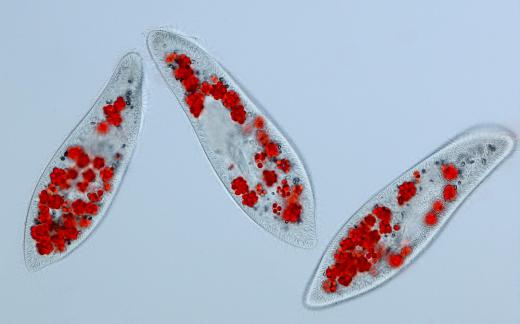What is a Traveling Microscope?
 Mary McMahon
Mary McMahon
A traveling microscope is a microscope which is used to measure very small objects. Accurate measurements on the scale viewable with a microscope are difficult or impossible to obtain with the naked eye; a traveling microscope allows a researcher to obtain a very accurate and precise measurement. These microscopes are used in a number of laboratory environments, and are manufactured by several companies which produce microscopes and related products. Because this type of microscope is a bit of a specialty item, it can be somewhat expensive, especially if it has very high levels of optical resolution.
Like a conventional microscope, a traveling microscope has a head fitted with lenses which can be used to magnify and focus on a small object. The head, however, is mounted on a slider which can be moved along a scale. With the object fixed in place, the head can be manipulated to take measurements of the object being studied. Classically, a traveling microscope uses a Vernier scale, a very precise type of scale utilized for scientific measurements because of its extreme accuracy and ability to measure very small increments.

Researchers can also mount a camera onto the microscope, using the camera to document the item they are studying and the measurement process. Documentation can be useful for a variety of reasons, ranging from wanting to document every stage of research in case disputes arise in the future to wanting to be able to connect the camera to a projector to show students and fellow researchers what is going on in real time.
Because a traveling microscope is fitted to a scale, it requires some special care. The microscope needs to be well maintained and protected from shock and impacts, as this could throw the calibration of the scale off. While being off to a small degree on a large measurement might not be viewed as the end of the world, measurements taking place on a microscopic level need to be very precise, because the error could be quite significant. Like other microscopes, the traveling microscope should be routinely covered when not in use to prevent dust from getting into the head of the microscope and to provide some protection from temperature changes.
Several companies sell used and refurbished traveling microscopes. This can be an appealing alternative to paying retail price on a brand new microscope. These microscopes are accompanied with a guarantee from the company which assures buyers that the microscope is properly calibrated and all of the parts are in working order.
AS FEATURED ON:
AS FEATURED ON:











Discussion Comments
@hamje32 - Computer image analysis is a boon to microscope technology; however it’s the old fashioned stuff that really makes the difference in my opinion.
Coming from the world of digital photography I can tell you that the lens you use makes all the difference. Having the best lens on the microscope will ensure that you get the clearest image with the highest resolution and detail.
Only then will the computer software be useful, since you will be working with the best data possible for analysis.
@David09 - Yeah, microscope software really paves the way for a level of understanding that is deeper than what you can get by just peering through the lens of a microscope.
Personally, I never had the patience to just sit still and stare through that little eyepiece for any length of time. If you upload images to your computer, however, you can not only do basic contrast and brightness of the images, but you can do a whole bunch of advanced image analysis as well.
The software can point out unique patterns of the thing you’re looking at, and I believe this would open up new vistas of discovery and lead to new scientific insights as well.
@everetra - I like the idea of mounting the camera to the microscope. This allows you to create dynamic readings of the specimen as you’re studying it.
Some time ago I bought my daughter a PC microscope. It wasn’t a traveling microscope, but it did have a camera attachment, and she was able to upload the pictures to her computer through a USB connection.
It was really cool and once we uploaded the images we could study them in detail at varying degrees of resolution. I honestly don’t believe she would have been as interested in the microscope without the camera and PC connection.
She started studying leaves and insects and a whole world of teeming life in the backyard. It really kick started her interest in science.
Just for clarification, I take it that the term “traveling microscope” has reference to the fact that the microscope is mounted on the scale. It’s not clear from the article but that’s what I gathered after a second reading.
The microscope “travels” on the scale back and forth, and hence the term. At first reading I thought it meant that the microscope was portable, something that you could travel with. However, most microscopes are portable so that couldn’t be it.
At any rate, I think that the use of the scale is very useful. It allows you to move back and forth to inspect your specimen as opposed to looking at it from one vantage point, or attempting to move the specimen with the microscope fixed in one location.
Post your comments